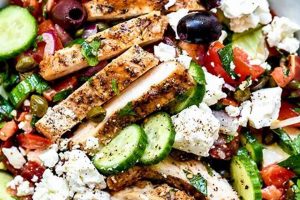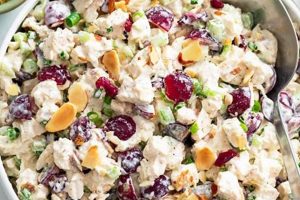A dish combining cooked chicken with a variety of fruits and often other ingredients like nuts, vegetables, and a creamy dressing creates a refreshing and flavorful meal or snack. Common fruits include grapes, apples, berries, and mandarin oranges. Mayonnaise, yogurt, or a vinaigrette typically bind the ingredients. Variations exist, offering diverse flavor profiles through the incorporation of spices, herbs, or cheeses.
This type of salad offers a balance of protein, vitamins, and healthy fats. It can be a light yet satisfying meal option, suitable for picnics, potlucks, or quick lunches. The versatility of such a dish allows for adaptations to different dietary needs and preferences, making it a popular choice for those seeking flavorful and nutritious meals. Its historical roots can be traced back to various culinary traditions that incorporate fruit with savory dishes, evolving into the contemporary preparations enjoyed today.
The following sections will delve into specific ingredient choices, preparation methods, nutritional information, and serving suggestions, providing a complete guide to creating and enjoying this culinary delight.
Tips for Creating a Delicious Chicken Salad with Fruit
Achieving optimal flavor and texture requires careful consideration of ingredients and techniques. The following tips offer guidance for preparing a successful dish.
Tip 1: Selecting the Chicken: Cooked chicken breast offers a lean protein base. Rotisserie chicken provides a convenient shortcut, while poaching or grilling allows for greater control over seasoning.
Tip 2: Fruit Selection and Preparation: Firm, slightly tart fruits like grapes, apples, and berries complement the savory chicken. Dice fruit into bite-sized pieces for even distribution and ease of consumption. Avoid overripe fruit, which can become mushy.
Tip 3: Balancing Sweetness and Acidity: A touch of acidity enhances the flavor profile. A squeeze of lemon juice or the addition of a tart apple variety can achieve this balance.
Tip 4: Choosing the Right Dressing: Mayonnaise offers a classic creamy texture, while Greek yogurt provides a lighter, tangier option. A simple vinaigrette adds a refreshing touch. Adjust the amount of dressing to achieve the desired consistency.
Tip 5: Incorporating Nuts and Seeds: Toasted nuts or seeds add a satisfying crunch and enhance the flavor complexity. Almonds, walnuts, pecans, or sunflower seeds work well.
Tip 6: Adding Herbs and Spices: Fresh herbs like tarragon, mint, or chives provide an aromatic lift. A pinch of celery seed, paprika, or curry powder can further enhance the flavor profile.
Tip 7: Chilling for Optimal Flavor: Allowing the salad to chill in the refrigerator for at least 30 minutes allows the flavors to meld and enhances the overall experience.
By following these tips, one can create a flavorful and balanced dish suitable for various occasions.
The provided insights aim to guide culinary exploration and ensure a satisfying outcome.
1. Chicken (cooked, diced)
Cooked, diced chicken forms the foundational protein component of a fruity chicken salad recipe. Its preparation method significantly influences the final dish’s flavor profile. Grilling imparts a smoky char, while poaching results in a more delicate, moist texture. Rotisserie chicken offers convenience. Dicing ensures even distribution throughout the salad and facilitates easier consumption. The size of the dice can be adjusted based on personal preference, but generally, smaller pieces integrate better with the other ingredients. The choice of chicken, whether breast, thigh, or a combination, affects both the nutritional content and the overall richness of the salad.
Consider a salad featuring grilled, diced chicken breast. The smoky notes of the chicken contrast beautifully with the sweetness of grapes and the tartness of apples. Conversely, poached, diced chicken, with its milder flavor, allows the nuances of the fruit and herbs to shine. Using rotisserie chicken offers a time-saving advantage, allowing for quicker assembly. Furthermore, the choice of chicken impacts the salad’s overall nutritional value; leaner breasts contribute less fat than thighs. Understanding these nuances allows for tailoring the recipe to specific dietary needs and preferences.
The proper preparation and incorporation of chicken are critical to the success of a fruity chicken salad recipe. Careful consideration of cooking methods and dicing techniques allows for a balanced and flavorful outcome. This understanding allows for greater control over the final dish, transforming a simple combination of ingredients into a culinary delight.
2. Fruit (fresh, varied)
Fresh, varied fruit forms an integral part of a successful fruity chicken salad recipe, contributing significantly to its flavor profile, textural complexity, and nutritional value. The selection of fruit directly influences the overall balance of sweetness, tartness, and aroma. Employing a variety of fruits creates a more nuanced and engaging sensory experience. The contrast in textures, from the crispness of apples to the juiciness of grapes, adds another layer of enjoyment. Furthermore, the inclusion of diverse fruits ensures a broader spectrum of vitamins and antioxidants, enhancing the nutritional benefits of the salad. For instance, incorporating berries provides antioxidants, while apples contribute fiber. The synergistic interplay of these elements elevates a simple chicken salad to a more complex and healthful dish.
Specific fruit choices offer distinct characteristics that can be strategically employed to achieve desired outcomes. Tart apples, such as Granny Smith, provide a refreshing counterpoint to the richness of the chicken and dressing. Sweet grapes, like red grapes, offer a burst of juiciness and a touch of natural sugar. Berries, such as blueberries or strawberries, introduce vibrant color and antioxidants. Tropical fruits, such as mango or pineapple, contribute a unique sweetness and tang. Understanding the individual characteristics of each fruit allows for careful orchestration of flavors and textures, transforming a basic recipe into a personalized culinary creation. Combining contrasting flavors and textures, such as tart green apples with sweet grapes, creates a dynamic interplay that enhances the overall appeal of the salad.
Successful integration of fresh, varied fruit necessitates careful consideration of ripeness, preparation techniques, and complementary ingredients. Overly ripe fruit can result in a mushy texture, detracting from the overall experience. Properly dicing or slicing fruit ensures even distribution and ease of consumption. The choice of dressing, whether mayonnaise-based or a vinaigrette, should complement the selected fruits. Balancing flavors and textures is crucial. A creamy dressing might pair well with sweeter fruits, while a vinaigrette might enhance the flavors of tart fruits. By understanding these interconnected factors, one can consistently create a harmonious and flavorful fruity chicken salad that offers both nutritional value and culinary satisfaction.
3. Dressing (creamy, light)
The dressing serves as a unifying element in a fruity chicken salad recipe, binding the diverse ingredients and contributing significantly to the overall flavor and textural experience. The choice of dressing, whether creamy or light, profoundly impacts the final dish’s character. A well-chosen dressing enhances the interplay of sweet and savory elements, creating a harmonious and balanced flavor profile. Understanding the role and impact of various dressing options is crucial for crafting a successful fruity chicken salad.
- Classic Creamy Dressings
Traditional mayonnaise-based dressings provide a rich, creamy texture that coats the ingredients and delivers a familiar comfort. Full-fat mayonnaise offers a classic flavor, while lighter versions reduce overall fat content. Variations incorporating sour cream or Greek yogurt introduce tangy notes. The richness of these dressings complements the sweetness of the fruit and the savory chicken, creating a balanced flavor profile. However, overly heavy dressings can mask the delicate flavors of the fruit. Therefore, moderation and careful selection are essential. A classic example is a mayonnaise-based dressing with a hint of lemon juice and Dijon mustard, offering a balance of richness and acidity.
- Light and Tangy Dressings
Vinaigrettes and yogurt-based dressings offer a lighter, brighter alternative to creamy dressings. These options typically incorporate an acidic element, such as vinegar or citrus juice, which enhances the flavors of the fruit and provides a refreshing counterpoint to the richness of the chicken. Greek yogurt offers a tangy, protein-rich base, while a simple vinaigrette allows the flavors of the other ingredients to shine. For example, a lemon vinaigrette with a touch of honey complements the sweetness of the fruit without overpowering the salad. These dressings contribute less fat than mayonnaise-based options, aligning with lighter dietary preferences.
- Balancing Flavor Profiles
The dressing should complement, not overpower, the other ingredients. Consider the sweetness of the chosen fruits and the savory notes of the chicken when selecting a dressing. A sweeter fruit combination might benefit from a tangier dressing, while tart fruits might pair well with a slightly sweeter or creamier option. The goal is to create a balanced flavor profile where no single element dominates. For example, a salad featuring sweeter fruits like grapes and mangoes pairs well with a tangy yogurt dressing, while a salad with tart apples and cranberries benefits from a slightly sweeter vinaigrette.
- Texture and Consistency
The dressing’s texture and consistency contribute significantly to the overall enjoyment of the salad. Creamy dressings provide a smooth, cohesive texture, while vinaigrettes offer a lighter, more distinct coating. The desired consistency depends on personal preference and the specific ingredients used. A thicker dressing might be preferred for a salad with larger chunks of fruit, while a thinner dressing might work better with smaller pieces. The texture of the dressing also interacts with the textures of the other ingredients, creating a multi-sensory experience.
The careful selection and application of dressing are crucial to achieving a harmonious balance of flavors and textures in a fruity chicken salad recipe. By understanding the interplay between creamy and light options and considering the specific characteristics of the chosen fruits and chicken, one can elevate a simple salad to a delightful culinary experience. The dressing acts as the conductor, orchestrating the various flavors and textures into a cohesive and satisfying whole.
4. Nuts/Seeds (optional, toasted)
The incorporation of nuts and seeds into a fruity chicken salad recipe offers both textural and flavor enhancements, elevating the dish beyond a simple combination of ingredients. Nuts and seeds contribute a desirable crunch, contrasting with the softer textures of the chicken and fruit. Their inherent flavors, ranging from the subtle sweetness of almonds to the robust earthiness of walnuts, add depth and complexity to the overall flavor profile. Toasted nuts and seeds offer an intensified flavor experience, their aromatic oils released through the toasting process. This process also enhances their crispness, further contributing to the textural interplay within the salad. Consider the addition of toasted slivered almonds, which provide a delicate crunch and subtle nutty flavor, complementing the sweetness of grapes and the savory chicken. Alternatively, toasted pecans offer a richer, more buttery flavor that pairs well with apples and cranberries. The choice of nuts or seeds should complement the other ingredients and contribute to a balanced flavor profile.
The optional nature of nuts and seeds allows for customization based on dietary restrictions, personal preferences, and desired flavor profiles. Individuals with nut allergies can easily omit this component without significantly compromising the core elements of the salad. Those seeking a lighter flavor profile might opt for milder nuts like almonds or sunflower seeds. Conversely, those desiring a more robust flavor experience might incorporate walnuts or pecans. The toasting process, while recommended for enhanced flavor and texture, can also be omitted if desired. Untoasted nuts and seeds offer a slightly different textural experience and a milder flavor, providing an alternative for those seeking a subtler nutty presence. For example, incorporating raw sunflower seeds provides a milder flavor and a slightly softer crunch compared to their toasted counterparts. This flexibility allows for tailoring the recipe to individual tastes and needs.
Strategic incorporation of nuts and seeds into a fruity chicken salad recipe offers significant culinary benefits. The interplay of textures and flavors enhances the overall sensory experience, transforming a simple salad into a more complex and satisfying dish. Understanding the impact of toasting and the flavor profiles of various nuts and seeds allows for informed choices that contribute to a balanced and harmonious culinary creation. This attention to detail elevates the dish from a basic combination of ingredients to a carefully crafted culinary experience. Whether toasted or untoasted, the judicious use of nuts and seeds adds depth and complexity, enhancing the overall enjoyment of a fruity chicken salad.
5. Seasoning (herbs, spices)
Seasoning plays a crucial role in elevating a fruity chicken salad recipe from simple to exceptional. Judicious use of herbs and spices enhances the inherent flavors of the chicken, fruit, and dressing, creating a more complex and nuanced flavor profile. The right combination of seasonings can brighten the sweetness of the fruit, complement the savory notes of the chicken, and add depth to the overall taste experience. The following facets explore the impact of specific herbs and spices in a fruity chicken salad context.
- Fresh Herbs
Fresh herbs offer vibrant, aromatic notes that brighten the flavors of a fruity chicken salad. Chives provide a delicate onion flavor that complements both chicken and fruit. Dill adds a slightly tangy, herbaceous note that pairs well with apples and grapes. Mint contributes a refreshing coolness that contrasts beautifully with sweeter fruits like berries or mango. Tarragon offers a subtle anise flavor that enhances the overall complexity of the salad. Fresh herbs should be added towards the end of the preparation process to retain their vibrant flavor and aroma. For example, incorporating fresh chives and dill enhances the savory notes of the chicken and complements the sweetness of grapes and apples.
- Dried Spices
Dried spices offer concentrated flavors that can add depth and warmth to a fruity chicken salad. A pinch of curry powder introduces a complex blend of warm spices. Paprika adds a subtle smokiness. Celery seed provides a savory depth that complements the chicken. Garlic powder offers a pungent savory note. Dried spices should be used sparingly to avoid overpowering the delicate flavors of the fruit. A small amount of curry powder, for example, can add a warm, savory depth that complements the sweetness of mango and the creaminess of the dressing.
- Balancing Flavors
The key to successful seasoning lies in achieving a balanced flavor profile. The herbs and spices should complement, not overpower, the other ingredients. Consider the sweetness of the fruit, the savory notes of the chicken, and the chosen dressing when selecting seasonings. A salad with sweeter fruits might benefit from herbs and spices with brighter, more assertive flavors. Conversely, a salad with tart fruits might benefit from more subtle seasonings. Balancing the flavors ensures that no single element dominates, creating a harmonious and enjoyable taste experience. A salad with sweeter fruits like grapes and berries pairs well with fresh mint and a hint of celery seed, while a salad with tart apples and cranberries benefits from the subtle anise flavor of tarragon and a touch of paprika.
- Enhancing Complexity
Strategic use of herbs and spices adds layers of complexity to a fruity chicken salad. Layering flavors creates a more nuanced and engaging taste experience. For example, combining fresh dill with a hint of curry powder adds both brightness and depth. Incorporating fresh mint with a touch of paprika introduces contrasting elements of coolness and warmth. This interplay of flavors elevates the salad beyond a simple combination of ingredients, transforming it into a more sophisticated culinary creation. A careful balance of herbs and spices can transform a basic fruity chicken salad into a dish with depth and complexity.
The thoughtful incorporation of herbs and spices elevates a fruity chicken salad recipe, enhancing its flavor profile and creating a more satisfying culinary experience. By understanding the individual characteristics of various herbs and spices and considering their interplay with the other ingredients, one can craft a balanced and flavorful dish that delights the palate. The strategic use of seasoning transforms a simple combination of ingredients into a more complex and nuanced culinary creation. From the bright, fresh notes of herbs to the warm, earthy tones of spices, seasoning plays a crucial role in achieving a harmonious and flavorful fruity chicken salad.
6. Chilling (enhances flavor)
Chilling significantly impacts the flavor profile of a fruity chicken salad recipe. Lower temperatures suppress volatile aromatic compounds, preventing their rapid dissipation and allowing flavors to meld and deepen. This process benefits the integration of diverse ingredientschicken, fruit, dressing, herbs, and spicescreating a more cohesive and harmonious flavor profile. Chilling allows the individual components, each with its unique flavor characteristics, to marry and mature, resulting in a more complex and balanced taste experience. For example, the sweetness of the fruit interacts with the savory notes of the chicken and the chosen dressing, creating a synergistic flavor enhancement achieved through chilling.
The practical significance of chilling relates directly to the overall enjoyment and quality of the fruity chicken salad. A chilled salad offers a more refreshing and palatable experience, particularly in warmer climates. The flavors are more pronounced and balanced, contributing to a more satisfying culinary experience. Furthermore, chilling helps maintain the structural integrity of the ingredients, preventing the fruit from becoming overly soft and the dressing from separating. This preservation of texture enhances the overall appeal and enjoyment of the dish. Consider a scenario where a freshly prepared salad, with all its vibrant flavors, is allowed to chill for a period. Upon consumption, the flavors are noticeably more integrated and balanced, offering a more refined culinary experience than immediate consumption would provide. This illustrates the practical impact of chilling on the final product.
Chilling represents a crucial step in optimizing the flavor profile of a fruity chicken salad recipe. It facilitates the harmonious integration of diverse ingredients, enhancing the overall taste experience. The practical benefits extend to improved palatability, textural preservation, and overall enjoyment. Understanding the impact of chilling empowers culinary practitioners to create a more refined and satisfying dish. Ignoring this step can result in a less flavorful and less enjoyable salad, highlighting the crucial role chilling plays in the final product’s quality.
Frequently Asked Questions
This section addresses common inquiries regarding the preparation and enjoyment of chicken salad incorporating fruit.
Question 1: What type of chicken works best?
Cooked chicken breast is often preferred for its lean protein content. Rotisserie chicken provides convenience, while grilling or poaching allows for customized seasoning.
Question 2: Which fruits complement chicken salad?
Apples, grapes, and berries provide a balance of sweetness and tartness. Consider texture and flavor compatibility when selecting fruits.
Question 3: Can canned fruit be used?
Fresh fruit is generally recommended for optimal flavor and texture. Canned fruit may introduce excess sweetness and a softer texture.
Question 4: What dressings are suitable?
Mayonnaise offers a classic creamy texture, while Greek yogurt provides a lighter alternative. Vinaigrettes add a refreshing tang.
Question 5: How long can chicken salad with fruit be stored?
Refrigerate for up to three days in an airtight container. Monitor for signs of spoilage before consuming.
Question 6: How can nutritional value be maximized?
Choose lean chicken, a variety of fruits, and a lighter dressing. Incorporate nuts and seeds for added healthy fats and fiber.
Careful selection of ingredients and proper storage ensure optimal flavor and freshness. Adaptation to individual dietary preferences is achievable through ingredient substitutions.
The following section provides illustrative recipe variations.
Fruity Chicken Salad Recipe
Exploration of this culinary combination reveals a dish offering versatility and nutritional value. Careful ingredient selection, from the protein base to the complementary fruits, nuts, and dressing, contributes significantly to the final product. Balancing flavors and textures, coupled with proper chilling techniques, enhances the overall dining experience. Consideration of dietary preferences and ingredient substitutions allows for recipe customization.
This dish represents more than a simple combination of ingredients; it embodies a culinary opportunity to create a balanced and flavorful meal. Further exploration of flavor profiles and ingredient combinations offers continued potential for culinary innovation. Understanding the underlying principles of preparation and ingredient interaction allows for consistent creation of a satisfying and healthful dish.






